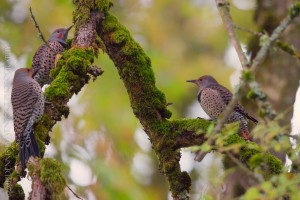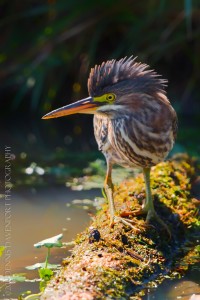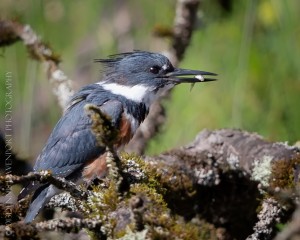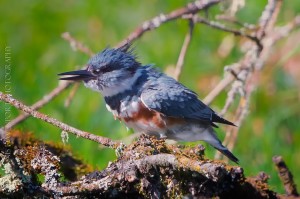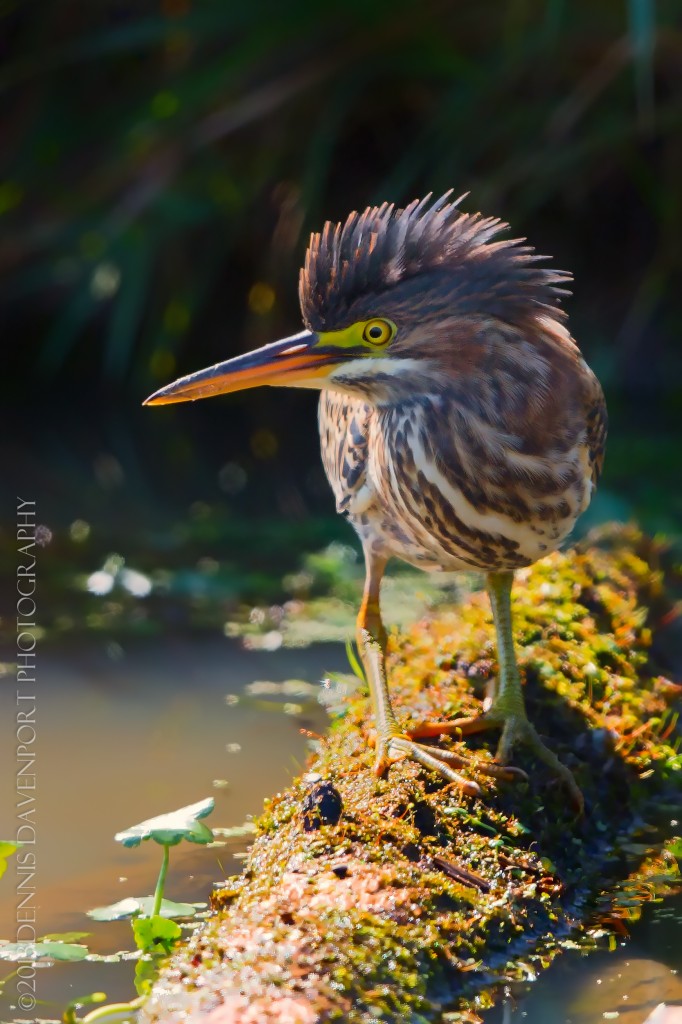Sep. 26 was another early fall day at the Ridgefield NWR, where the wildlife activity was much below what I would prefer. But when I limit myself to shooting wildlife in their natural wildlife settings and habitats, I know to expect these kinds of days especially at this time of year. It’s not going to keep me from trying and I still will not use bait or setups to take my pictures, even though under controlled conditions a photographer can come up with some awful nice photographs using setups and the like.
So, here are eight shots I wanted to share. A couple aren’t bad, the rest are good documentary shots to assist in showing you what I saw this day out in the wild.
To start off, while driving the gravel road of the refuge, I hear a commotion of sorts to my left in a very shaded area about 50-60 feet away. I could barely make out with my naked eye that what I was hearing was a group of three (Red-shafted) Northern Flickers perched together on some mossy branches. I’m assuming this is a family of birds with the two parents and a youngster. At one point the male parent flew over to a nearby trunk, all the while vocalizing to the other birds to his right. He’d then fly back to the group and vocalize some more. In this shaded area, I had to crank up the ISO to 3200 at F4 even to get a shutter speed of 1/400. Even at that I think I underexposed the shot requiring me to introduce some noise when lightening it up in post processing. That, and other obvious factors, make this shot one of the documentary shots of the day. But it was nice to see and capture this family of birds interacting as they did. (8:02 a.m.) Canon 5D Mark III, 500mm. Focus was on the bird to the right (which I believe is the juvenile).
[Clicking once on the thumbnails will give you a larger view of the images].
In the water near marker #2, a Great Egret walked into the nicely colored water on the left side of the road. The shot was taken just as the bird nabbed a small morsel from the water. I was pleased with the reflection and also the position of the bird’s foot up out of the water. The fish it caught was not exactly something to be proud of but I guess it’s better than nothing. Canon 5D Mark III, 1/1000, f4, ISO 640, 500mm. (9:26)
With this next image, the point was driven home to me that no matter how good a lens you think you have, there is no substitute for good technique. Near marker #2, I locked onto a Green Heron that was about 60 feet away when I first encountered it. I also want to point out that the bird was backlit and usually half in the shade and half in direct sunlight as it walked and hopped its way closer to me, ending up about 25 feet away. Another challenge was the bright spots the sun was making on the water surface. Even with these lighting issues, I was happy to get a relatively close shot, with few obstructions, at 500mm. I took a lot of shots, but in doing so, tried to be selective where the bird’s head and eye were not washed out by the bright direct sun. So I exposed for the shade and tried to get head shots that were in the shade. When I got home and looked at the shots I took, I had more to worry about than just bad lighting. Not one image was tack sharp, as I expected most of them to be at such a short range. I was shooting on a bean bag so I thought the lens was steady when I shot the pictures. I’m thinking though that since I was shooting most of the shots when the bird’s head was in the shade, that maybe a combination of low contrast on the bird coupled with very bright backlit conditions could have caused some auto-focus issues. Another possibility is that I could have unintentionally turned the manual focus ring which actually touches the bean bag–but I wouldn’t think I did that for every single shot. Somewhere I messed up though because this lens is sharp when used correctly. Here’s one shot that had the least light issues and also was sort of sharp. I really like these birds and I see them so rarely I just had to post one shot! Canon 5D Mark III, 1/2000, f4, ISO 800, 500mm. (12:21 p.m.)
My next adventure was in the Ash tree forest where I heard and saw the usually skittish Belted Kingfisher. It had perched on a bare branch that protruded out over the water maybe 6 to 8 feet above it. I was an average of 50-75 feet away from the bird depending on which perch it flew to–of which there were several. Again, light was challenging as the noon-time direct sun was shining down on the bird and its pose determined whether I snapped the shutter. This time I waited for the bird’s head and eye to be in the direct sunlight and that is what I exposed for. For 12 minutes I watched this bird change perches and had to start my engine and drive ahead a couple of times to catch up to it. But it really paid me no mind. It dove for fish several times while I was watching. I took nearly 200 shots of this bird hoping the questionable light would not ruin all the shots. When I got home to view the shots, I was happy to see that almost all of them were nearly tack sharp—or as tack sharp as I think they could be for such a small bird at that distance. These were much sharper than any of the Green Heron shots I talked about above–a bird twice as large and at more than twice the distance. Because all the perches were up off the water, I did not have to contend with bright water reflections but there were some obstructions on some of the poses. All in all, I was very happy with the detail in this set of shots especially for the conditions and distance. I did have a much more contrasty target to focus on here with less light challenges which may have accounted for the much more accurate focus. Or, maybe I just used better technique. Take a look at these in large view and see what you think. Canon 5D Mark III, 1/2500, f5, ISO 1250, 500mm. (12:43 p.m.)
Canon 5D Mark III, 1/2500, f4, ISO 800, 500mm. (12:45 p.m.)
Canon 5D Mark III, 1/2500, f4, ISO 800, 500mm. (12:47 p.m.)
The bird had just come back from diving and is finishing a shaking motion to remove the excess water. Canon 5D Mark III, 1/2500, f4, ISO 800, 500mm. (12:50 p.m.)
It was approaching 2 p.m. when I was driving down the home stretch of the loop gravel road and ready to call it a day. In the field off to my left was a Great Blue Heron hoping to catch a vole. It was nearly a hundred feet away and one more bird to take some pictures of. I took just a few shots and in the image below the bird has its nictitating membrane over the eye. I call this shot, “The Thinker.” Canon 5D Mark III, 1/2000, f4, ISO 800, 500mm. (1:41 p.m.)
For those who are photographers– Most photographers have probably heard by now that Adobe has priced their Photography Package for Photoshop and Lightroom at $9.99/mo. for those who own CS3 or later and for those who sign up by the end of the year. I recently signed up for the package. My normal procedure was to buy each upgrade to both programs anyway, which was costing me over $15/mo. on average (based on an 18 month upgrade timeline). So $10 a month looked good to me and the fact that this is not an introductory price, sold me. It’s also nice to get upgrades as they are developed instead of having to wait 18 months.
One of the nice upgrades in Photoshop CC is the Smart Sharpen filter, which has been improved. Currently, I prefer it over Lightroom’s sharpen and also Nik’s Sharpener Pro. The PS radius slider allows choosing all the way down to .1, where Lightroom has a minimum of .5, which allows for a very minute sharpening adjustment. The filter seems to know what part of the image should be sharpened and what should not. And, of course, you can select the part of the image you want sharpened prior to invoking the filter. It also has a slider for luminance noise which is very handy.
I’ve also tried the new Shake Reduction filter. This can do wonders for some slightly OOF parts of birds if used lightly. It’s not a cure all for all situations but it’s easy to try it and see the results.
If you’re on the fence about trying the Adobe Photography package, download a free trial and take it for a spin.
Regarding the government shutdown, and without getting into the political aspects of this mess, I have been shut out of my primary wildlife shooting area due to the ‘government shutdown.’ The Ridgefield NWR (and all other national refuges) are run by a federal agency which is required to close the refuges. I’ve missed one week so far and hope this doesn’t last long. I’m really itching to get out and shoot more with the new lens.
In the mean time, I have ordered a Canon 2x III extender and am anxious to get out and try it with the 500mm lens. I should receive it by the time I get out to shoot again.
